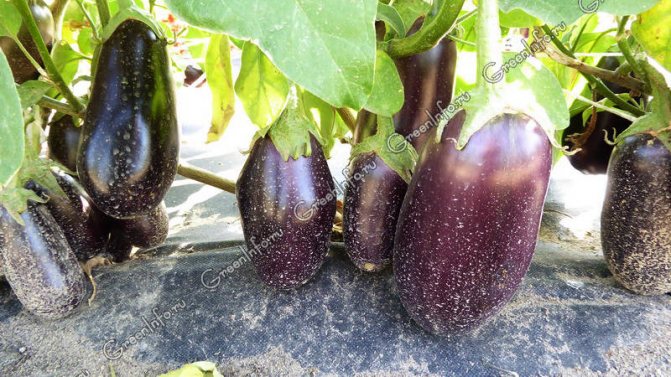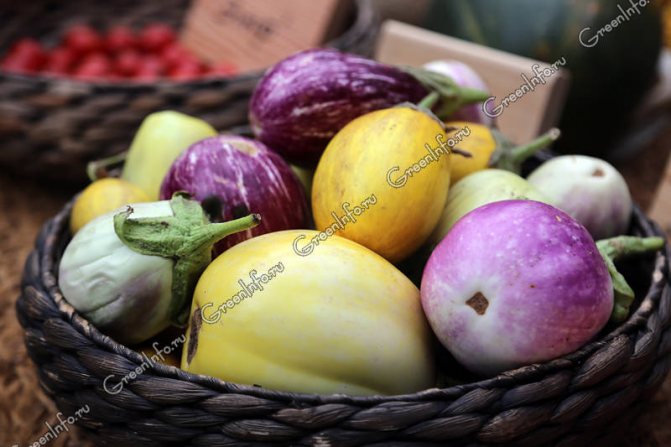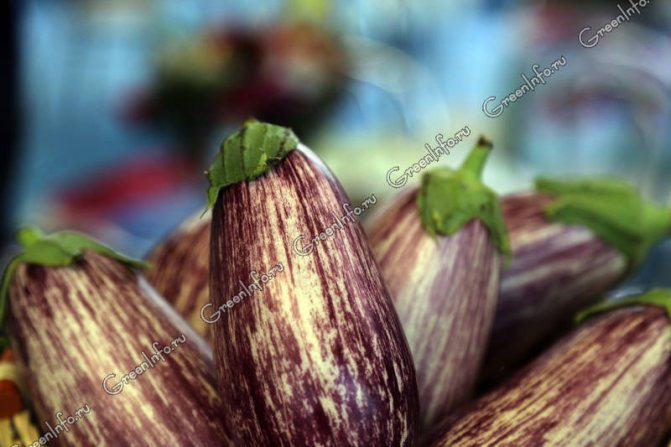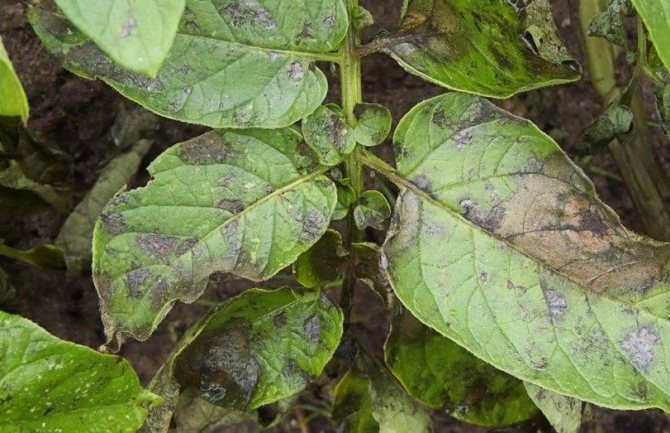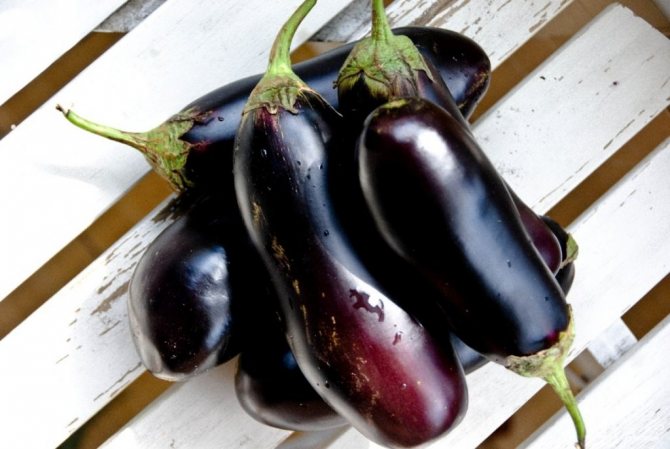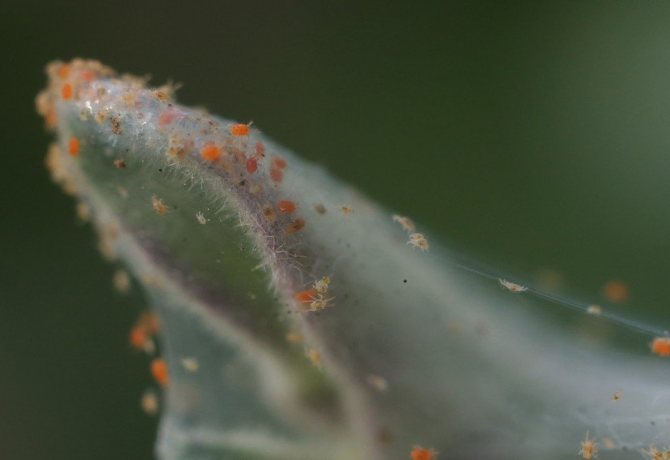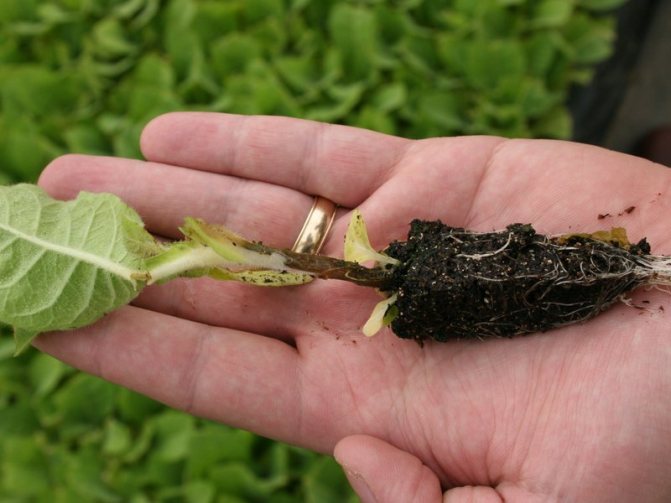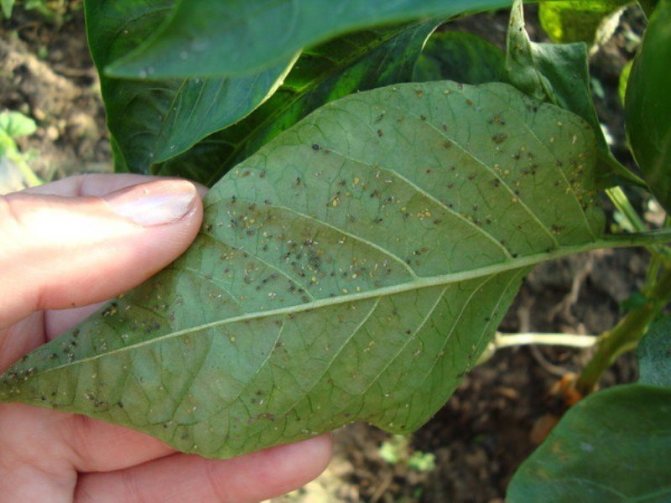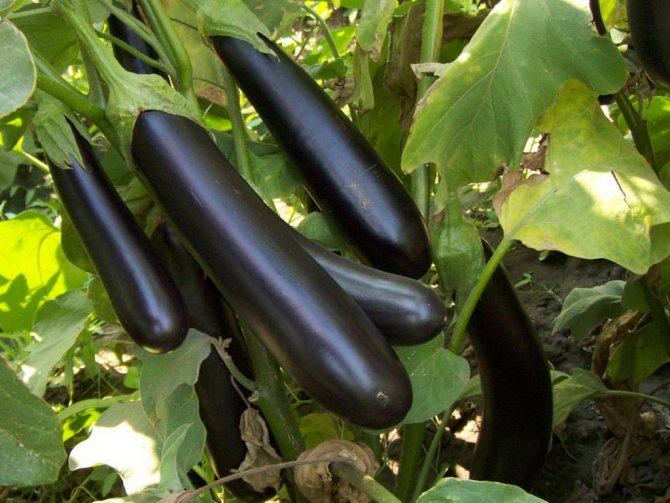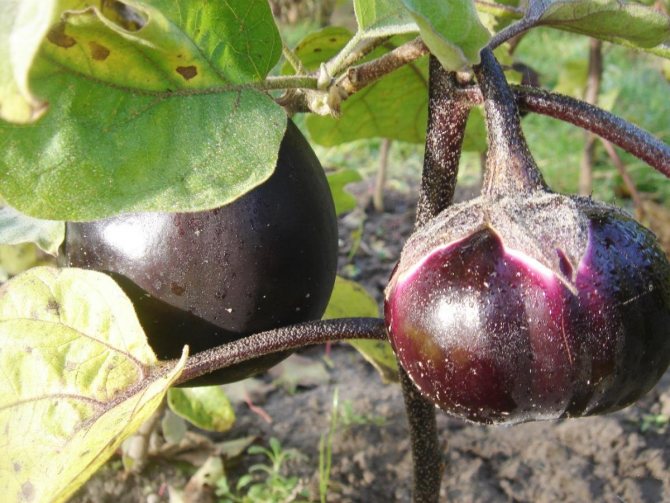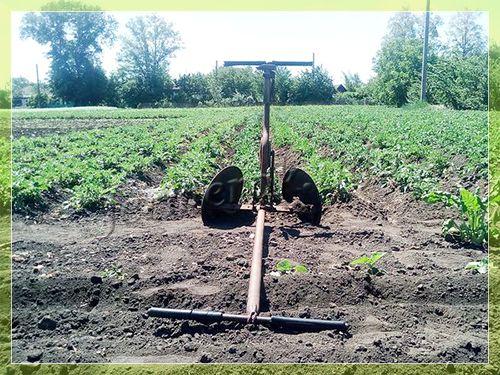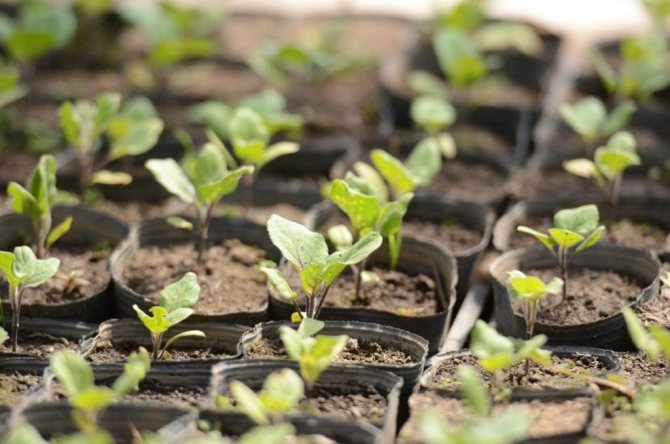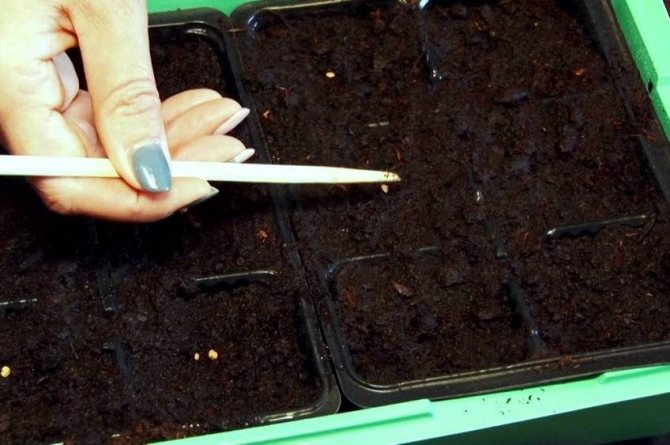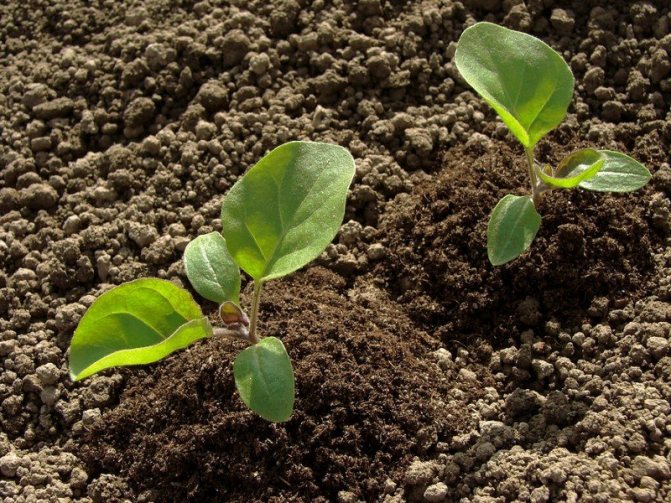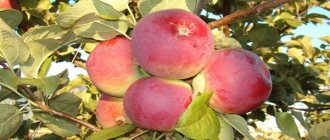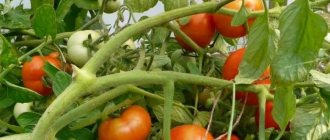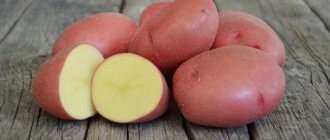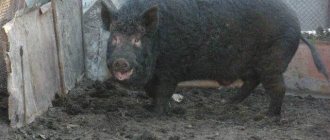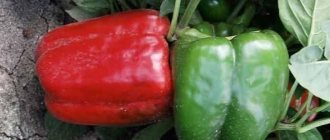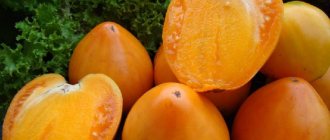Eggplant Bourgeois f1 is an early ripe hybrid capable of bearing fruit one hundred and ten days after planting and bearing fruit before frost. The hybrid is adapted for outdoor growth. Can be grown in greenhouses. Resistant to adverse weather conditions and the most common diseases.
A very large, tall shrub with round fruits that are not inferior to the plant itself. In favorable conditions, the bush can grow up to 170 cm. The weight of eggplants ranges from four hundred to six hundred grams. With such a weight of fruits and a significant height of the bush, it is better to tie the plant to the trellis. The bushes of the Bourgeois hybrid are quite spreading. A good ratio of bushes to unit area is three plants per square meter.
The fruits of the hybrid have a slightly flattened shape. The skin of a ripe eggplant is very dark, almost black with a purple tint. The pulp is not bitter, very tender, white. Suitable for preservation for the winter and for preparing dishes from fresh eggplants. The shape of the fruit is very convenient for cooking stuffed eggplants in the oven.
The fruits of the eggplant Bourgeois at the stage of technical ripeness have a violet-pink color.
We can say that round eggplants have returned to their original fruit appearance. Same as in the photo.
At the same time, cultivated round-fruit eggplants, while retaining the shape of the fruit, acquired high taste and significant sizes. But they lost the protective thorns on the stems, leaves and calyx. And also a significant part of the bitterness. In the wild, the eggplant needed all this to protect itself from the pests that eat it.

Yes. This is an eggplant. Wild.
In the garden culture, the role of plant protector was assumed by man.
If we compare the top photos with the photo of the Bourgeois eggplant, it is clearly noticeable how much the size and weight of the fruits have increased.
And how much "kinder" the eggplants have become towards humans.
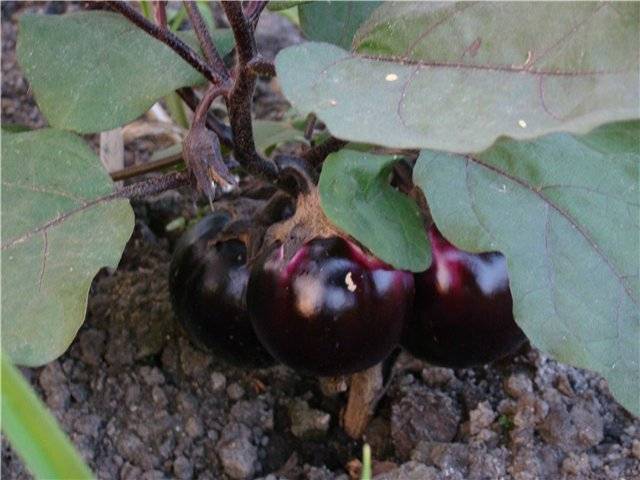

Description of eggplant Bourgeois
The Bourgeois hybrid appeared as a result of crossing several varieties... Due to this, it has increased resistance to diseases and pests, tolerates sudden changes in temperature, frost and rain.
Distinctive features
The hybrid is grown both in the greenhouse and in the open air... An early ripe vegetable ripens 105–110 days after planting. The bush is large, the foliage is dense. The plant reaches a height of 150–170 cm. Due to the abundance of fruits, the bush needs a garter, otherwise the stems will break under the weight of ripe eggplants.
Fruit characteristics and yield


The fruits have a flattened round shape and a dark purple color with a glossy sheen... The weight of the eggplant varies from 400 to 600 g. The pulp is white, without bitterness, and the taste is tender. The yield is high, from 1 sq. m, about 5 kg of juicy fruits are harvested.
Interesting! In the East, eggplant is called a longevity vegetable. Moderate consumption of the product improves the functioning of the circulatory system and promotes weight loss. 100 g of pulp contains only 28 kcal. The fiber in the fruit removes excess fluid from the body and contributes to weight loss. Thanks to the content of vitamin PP, eggplant helps to get rid of nicotine addiction.
Characteristics of the variety
The Bourgeois eggplant variety is an early ripe hybrid, the fruits of which ripen 100 days after the seed is planted. It bears fruit before the onset of frost.The bourgeois grows under the open sky and in greenhouses. The variety has developed resistance to bad weather conditions and diseases.
Description of the variety
According to the description, Bourgeois has a large, tall and spreading bush with round fruits, the height of the bush reaches 170 cm. For 1 sq. m fits 3 plants.
Description of the fetus
The fruits of the plant are large, weigh 400-600 g, reach 10 cm in diameter, have a flattened shape. At the stage of ripeness, the vegetables are purple-pink.
The plant requires tying to a support, since the bush has heavy fruits and grows tall. A ripe vegetable has an almost black skin with a purple tint. The pulp is white, not bitter. Vegetables of the Bourgeois variety are used for conservation, the shape of the fruit is convenient for stuffing.
Read also: Review of the best varieties of zucchini for the Urals and Siberia with photos and descriptions
How to grow eggplant yourself
Grow a hybrid seedling method... Seedlings help the seedlings adapt to external conditions and prevent disease.
Growing seedlings
Seedlings are prepared 2-3 weeks before planting eggplants on the site... This requires a seed container, such as flower pots, plastic cups or kefir boxes. The main thing before planting is to rinse the container and wipe it with a clean towel.
Land from the garden is used as soil... It is cleaned of debris and weeds, heated in the oven for two hours at a temperature of +180 ° C. Many people prefer to use ready-made soil formulations from the store, since they are already disinfected in advance and enriched with nutrients for better plant development.
Next, the planting material is disinfected by placing it in a solution of potassium permanganate for a day... The procedure kills dangerous microbes on the surface of the seeds and prevents diseases. After the inoculum is germinated by placing it in a damp gauze for 2-3 days. Germination improves germination.
Earth is poured into the container and small grooves are made with a depth of 1-2 cm... Two seeds are dipped into each, sprinkled with earth and gently slammed.
Water the seedlings with warm and clean water... Store in a warm and sunny place, for example, on a windowsill. If the windows face the north side, additional illumination with fluorescent lamps is arranged. Seedlings are watered once every 10 days. Fertilize twice with liquid organic fertilizers. 5 days before planting in open ground, the seedlings are hardened - taken out to the balcony 3-4 hours daily.
Transfer
Eggplants are grown on fertile sandy loam soils... The beds are dug up, cleaned of the remnants of last year's plants, and the grass and foliage are removed. The best predecessors for eggplant are cabbage, carrots, and beets. It is not recommended to plant the vegetable after potatoes or peppers. The soil is watered with liquid manure and river sand is added for friability. The optimal size of the beds for the Bourgeois eggplant is 1000 × 30 cm.
Transplant seedlings into open ground on a calm, cool day... For 1 sq. m place no more than 3 bushes. Water is poured into the prepared holes, then the seedlings are placed. Sprinkle the roots with earth and dry sawdust on top. The next watering will be organized in a week.
Important! If the bourgeois eggplant is planted in a greenhouse, the walls and doors are pre-wiped with the "Effecton" preparation. It destroys dangerous microbes and pathogenic microflora.
Further care
Water the beds as they dry... If the summer is hot and humid, the earth is moistened once every 7 days; in dry weather - every 5 days. Use warm water previously heated in the sun. Water the plants under the root, bypassing the stems and leaves. After rains and watering, the soil is loosened and weeds are removed. Such procedures improve microflora and oxygenate the soil. Eggplants are huddled every 2 weeks to strengthen the stems.
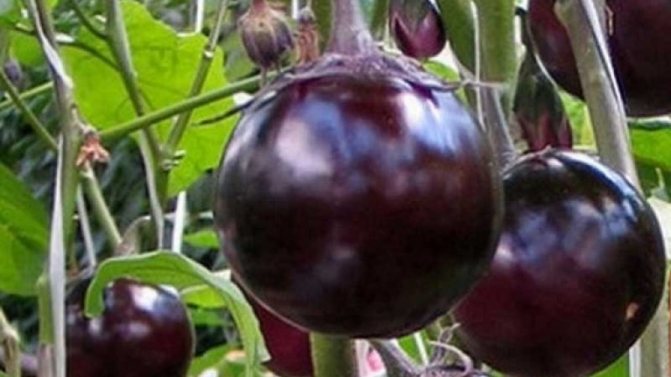

Particular attention is paid to organic and mineral feeding:
- 2 weeks after planting, the beds are watered with liquid manure or an ash solution. Organics improve the palatability of the fruit and prevent the appearance of insects.
- During the flowering period, plants are fertilized with superphosphate or potassium salt. Fertilizers are pre-dissolved in warm water.
- 3 weeks before harvest, the bushes are sprayed with soapy water or Bordeaux liquid to protect against diseases.
Read also: When to remove bees for the winter in Bashkiria
Features of cultivation and possible difficulties
If 4-5 fruits ripen on the bush at the same time, the plant is tied to a support... Near each eggplant, a wooden peg is driven into the ground, which is wiped with a solution of potassium permanganate in advance. The stems are tied neatly; the knots cannot be tightened strongly. After the formation of the first fruits, all lateral shoots are removed. During cultivation, the plants are regularly inspected for spots or other defects. Examinations help to detect diseases at an early stage and prevent their development.
Important! Thickened planting and lack of sunlight lead to the fact that the fruits do not gain purple color, but remain light.
Attention is also paid to mineral feeding. To avoid sunburn, they are applied only after watering.... Before use, summer residents carefully study the dosages and recommendations. An excess of potassium leads to leaf curling, and nitrogen - to an increase in green mass and slower fruit growth.
Diseases and pests
The most common eggplant disease is stolbur... Disease appears due to weeds or insects. Signs of a columnar: thickening of the stem, deformation of flowers, drying of leaves. As a preventive measure, seeds are disinfected and the rules of crop rotation are observed. For treatment, drugs "Actellik" or "Fitosporin" are used.
There is also a tobacco mosaic on eggplant beds.... She is recognized by the white bloom, which becomes more and more over time. For prophylaxis, plants are sprayed with soapy water. In case of illness, infected bushes are eliminated from the beds and burned.
Eggplants are attacked from pests spider mite and aphids... Insects appear due to improper care, sudden changes in weather, watering with cold water. Effective remedies against pests are Strela and Sonnet preparations. In order to prevent it, the soil is loosened, weeds are removed and the rules for the introduction of organic and mineral dressings are observed.
Other varieties of eggplant:
Growing
The Bourgeois f1 variety is grown in seedlings.
Planting seeds
Seeds are sown for seedlings from late January to early March, depending on climatic conditions.
The seedlings should be 2 months old when the frost ends. Seed germination is slow, from 8 to 13 days - before sowing, they should be treated with a growth stimulator according to the instructions. Use a damp cloth to germinate the seeds. Then they are placed in separate pots.
Sprout care
Eggplant Bourgeois f1 does not tolerate picking and transplanting, it may stop growing, so it is grown in a pot and transferred to a permanent place. The favorable temperature for growing seedlings is 25 ° C during the day and 18 ° C at night. When watering, you need to know when to stop, otherwise the roots, trunk, and plants may die from excess moisture.
Transplanting
Plants are transplanted to areas with good lighting, closed from the north wind, with nutritious soil. For the looseness of the earth, humus, peat and sawdust are added under the eggplants. It is forbidden to plant eggplants in the same place for 2 years in a row, they do not plant them in place after growing potatoes and tomatoes.
Planting vegetables means:
- preparation of a pit to the depth of a shovel bayonet;
- filling the pit with water;
- lowering the plant into the resulting slurry, deepening not lower than the cotyledonous leaves;
- sprinkling with earth.
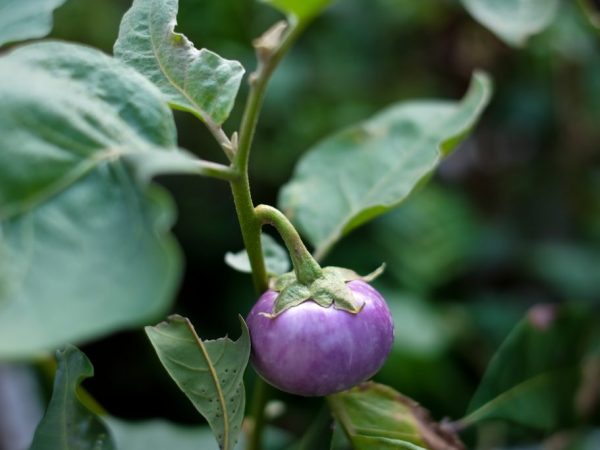

Plants require proper care
Plants require proper care of them. They need regular watering, weeding, loosening the soil, forming a bush, feeding and treating diseases and pests. Cultures of the Bourgeois variety love the sun. If the leaves darken the flowers, they are removed. Bushes Bourgeois F1 grow tall and with heavy fruits, they are tied to pegs.
The Bourgeois variety is fed 3 times per summer:
- 2-3 weeks after planting;
- at the beginning of fruit formation on lateral shoots;
- at the beginning of the main fees.
Plants are fed with solutions of ammophoska, urea, superphosphate at the rate of 10-40 g per 1 liter. From organic substances, infusions of chicken manure and mullein are used. Suitable for feeding and green fertilizer. For its preparation, weeds are taken and placed in a barrel, then they are poured with water and left for 7 days to ferment. The resulting mixture is diluted in a ratio of 1: 5 and watered with 0.5-1 liters under the plant.
Watering seedlings Bourgeois F1 is carried out first every other day, then reduced to 2 times a week. When dry, flowers and ovaries begin to crumble, the fruits become ugly. The soil under the Bourgeois is covered with humus or straw, while the roots will be warm, the growth of weeds will slow down.
Harvesting and application of the crop
Eggplant Bourgeois is harvested in August... Technical ripeness occurs 30–40 days after flowering. The fruits gain weight and rich color, become firm and elastic. Pick vegetables as they ripen. It is impossible to overexpose them on the bushes: the pulp loses its taste, becomes bitter. Cut the eggplants together with the stalk - this way they are stored longer.
Early maturing eggplant Bourgeois, therefore, the bulk of the harvest is eaten as early as possible. First of all, fruits with scratches or dents are processed. Eggplants are stored in a cool place for no more than 3 weeks.
Important! In the light, the vegetable produces solanine, an element dangerous to human health. Therefore, for storage, the crop is placed in dark plastic bags.
Due to its shape, the Bourgeois eggplant serves as an excellent base for stuffed baked dishes.... The vegetable is harmoniously combined with mushroom, vegetable and meat fillings. Its taste is emphasized by seafood, creamy sauces, dried fruits and spices. Housewives use the harvest for processing and harvesting useful winter preparations. Pickled and canned eggplants are in harmony with tomatoes, cucumbers and peppers. The appetizers are spiced up with garlic, a mixture of peppers, vinegar and a mixture of Provencal herbs.
Interesting! Eggplant is one of the main ingredients for the Italian spice pie. The recipe also includes minced meat, salted curd cheese, thyme, shallots. Such a pie is an excellent dish for a festive table.


Advantages and disadvantages
The advantages of the hybrid include an attractive appearance of the fruit and tasty pulp.... Vitamin salads and winter preparations, side dishes and stuffed dishes are prepared from the vegetable. The plant is unpretentious in care, rarely gets sick, has immunity to insect pests. The hybrid shows stable and high yields both outdoors and in greenhouse conditions.
Of the shortcomings, the need for a garter and the formation of a bush is noted.... No more than three stepsons are left on one plant.
Preparing the soil for planting
In order for the seedlings to take root in a new place, the soil must be properly prepared:
- in the fall, the site is dug up and organic fertilizers are applied;
- then sprinkle with limestone to reduce acidity;
- it is recommended to put sawdust or dry grass under the layer of earth to insulate the garden, because eggplants love warmth.
You should not plant eggplants 2 times in the same place in order to reduce the risk of diseases and pests of nightshades.
Transplanting
When the soil warms up to 15 degrees (approximately in the second half of May), the seedlings can be transplanted into open ground.For this:
- Dig holes 25-30 cm deep.
- Sprinkle abundantly with warm water.
- A bush with a lump of earth is transferred into the hole.
- They are covered with earth, but not compacted, so as not to reduce the air permeability of the soil.
The first 14 days, seedlings are watered every other day with warm water.
Read more about how to grow eggplant seedlings in the article: When and how to plant eggplant seedlings: step by step instructions
Reviews of experienced gardeners
Reviews about eggplant Bourgeois are mostly positive... However, sometimes there are neutral or negative comments.
Victoria, Saratov: “I planted Bourgeois eggplant last year. The manufacturer's promises matched the result. The hybrid does not require much attention to itself, it is resistant to abrupt climatic changes. The taste of the fruit is soft, not bitter. "
Olga, Moscow: “The bushes grew up to 1.5 m, a month later I tied them to a support. The fruits were tied together, the return is excellent. Fertilized with liquid manure and ammonium nitrate. Used to prepare baked dishes and stuffed with meat filling. "
Igor, Oryol: “Bourgeois eggplant attracted with its round fruits. I planted it in a greenhouse, expecting to get large vegetables. However, the maximum weight of the fruit reached only 300 g. I looked after regularly, what is the reason for the poor harvest - I do not know. Perhaps it's the soil. "
Description of the variety Bourgeois F1
Bourgeois F1 is a hybrid of early maturing eggplant, the fruits can be eaten as early as 105-110 days after germination. The bushes are not very wide, not very spreading, up to 1.6 m in height. Support and a garter are not required for them. The stem is slightly pubescent, anthocyanin. The leaves are green, medium-sized, with a wavy edge.


The weight of one eggplant is within 330 g, record figures of 500-600 g
Fruits are spherical, almost completely round, similar to a tomato, up to 13 cm in diameter. The weight of one eggplant is within 330 g, record figures are 500-600 g. The peel is dark purple, shiny. There are almost no thorns on the calyx. The pulp is white, with a green tint, dense, without bitterness.
Variety characteristics
- The bourgeois is distinguished by its early ripening period. From the moment of germination to the start of harvesting, 105 - 110 days pass;
- the yield of commercial products is 4.7 kg / square meter, in greenhouses this figure may increase;
- long-term fruiting;
- is resistant to bacterial and viral infections;
- the harvested crop perfectly tolerates long-term storage and transportation over long distances;
- in use, eggplant is absolutely universal. It can be boiled, fried, grilled, baked, pickled, canned.
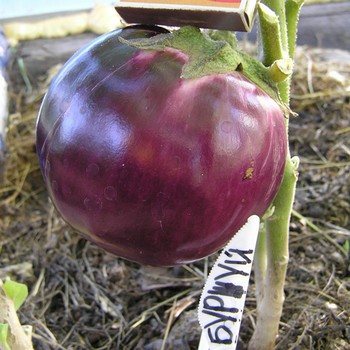

Characteristics of eggplant Bourgeois F1
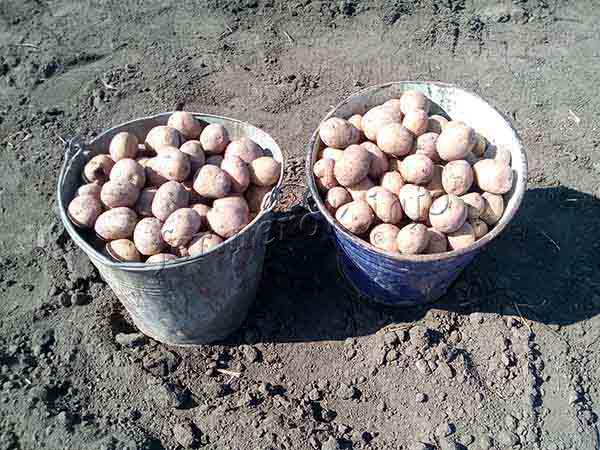

Each type of eggplant has its own quality characteristics. What features does the eggplant Bourgeois F1 have?
- The yield is stable, up to 4.7 kg / m. sq. The variety is appreciated for the fact that it never lets gardeners down, with proper agricultural technology.
- The fruits are large, beautiful, fleshy and tasty.
- The harvest does not ripen together, but gradually over the course of 1-1.5 months.
- The commercial qualities are good. The fruits do not lose their presentable appearance for a long time, they attract the attention of buyers with an unusual shape and rich color of the fruits.
- You can transport crops over long distances.
- Resistant to some diseases, can grow in unfavorable climates.
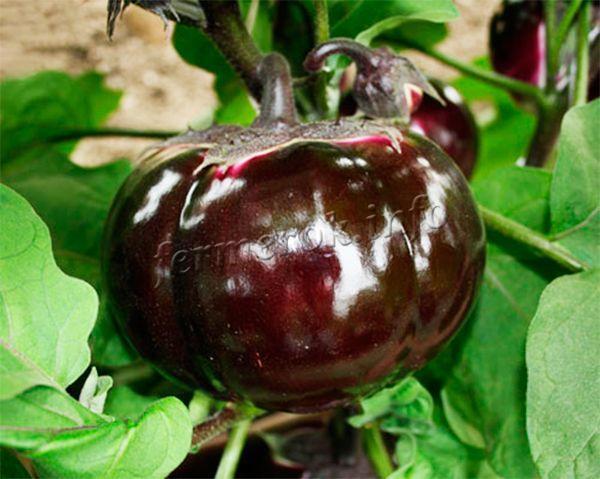

The fruits are large, beautiful, fleshy and tasty.
What to look for when choosing the best varieties of eggplant for greenhouses and open ground
The most important indicators to look out for when choosing eggplant seeds for planting are:
- ripening terms (their range fits into values from 100 days to 5 months);
- the height of the plant stems;
- adaptability to a specific climate;
- endurance to a sudden drop in temperature.
Experienced gardeners (in the selection recommendations) focus on early varieties of eggplant with low stems in order to place them in open beds.The rest will have to be planted in greenhouses or greenhouses, because in many regions of our country they simply will not have time to ripen in unprotected beds.
What are the features of growing Bourgeois F1?


You can plant eggplant Bourgeois F1 both in open and closed ground. It grows well in any cultivation, but the better the care, the more you can harvest. So how do you properly plant and care for your hybrid?
- As stated above, it is not necessary to tie this hybrid. However, if the harvest is large, and several fruits ripen on each plant at the same time, it is worthwhile to carry out a garter so that the bushes do not break under the weight.
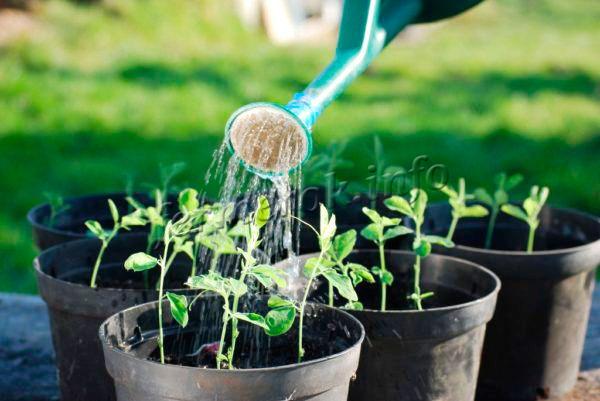

The easiest way to grow the variety is by the seedling method.
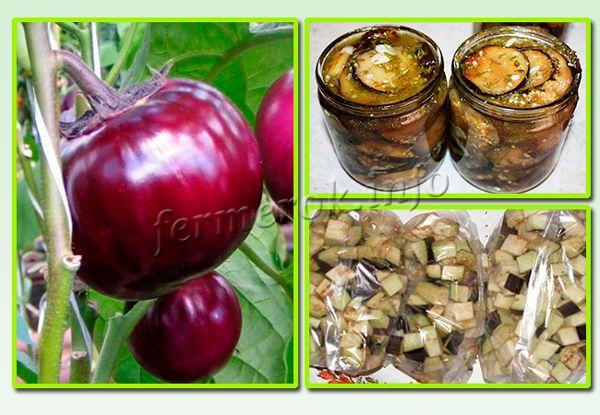

Eggplant Bourgeois F1 has universal use
Diseases and pests
Eggplant Bourgeois F1 is susceptible to the following diseases and pests:
- Fitovtoroz. Brown spots appear on the leaves, spread to fruits and stems.
- Blackleg. The basal part of the stem darkens, becomes thin and breaks.
- Anthracnose. On the leaves appear oval brown spots, on the fruits - depressed, which then turn into cracks.
- The Colorado potato beetle harms the leaves of the plant.
- The spider mite affects the leaves, they dry out, turn yellow, their growth worsens, and the yield decreases.
How to handle the crop?
Eggplants Bourgeois F1 have universal use. They are often canned, made first, second courses, snacks. The fruits are very convenient to use for stuffing. After heat treatment, the pulp does not lose its taste, rather tender, juicy.
If it is necessary to store the fruits all winter, it is worth preserving them or freezing them. The second option has recently become more and more popular. When frozen, nutrients from a vegetable do not evaporate, as during hot processing. Frozen eggplant, cut into slices, can be stored for up to several months.
VIDEO - 10 Commandments for Growing Eggplant
Eggplant Bourgeois f1 is an early ripe hybrid capable of bearing fruit one hundred and ten days after planting and bearing fruit before frost. The hybrid is adapted for outdoor growth. Can be grown in greenhouses. Resistant to adverse weather conditions and the most common diseases.
A very large, tall shrub with round fruits that are not inferior to the plant itself. In favorable conditions, the bush can grow up to 170 cm. The weight of eggplants ranges from four hundred to six hundred grams. With such a weight of fruits and a significant height of the bush, it is better to tie the plant to the trellis. The bushes of the Bourgeois hybrid are quite spreading. A good ratio of bushes to unit area is three plants per square meter.
The fruits of the hybrid have a slightly flattened shape. The skin of a ripe eggplant is very dark, almost black with a purple tint. The pulp is not bitter, very tender, white. Suitable for preservation for the winter and for preparing dishes from fresh eggplants. The shape of the fruit is very convenient for cooking stuffed eggplants in the oven.
Read also: How to make whitewash chalk
The fruits of the eggplant Bourgeois at the stage of technical ripeness have a violet-pink color.
We can say that round eggplants have returned to their original fruit appearance. Same as in the photo.
At the same time, cultivated round-fruit eggplants, while retaining the shape of the fruit, acquired high taste and significant sizes. But they lost the protective thorns on the stems, leaves and calyx. And also a significant part of the bitterness. In the wild, the eggplant needed all this to protect itself from the pests that eat it.
Yes. This is an eggplant. Wild.
In the garden culture, the role of plant protector was assumed by man.
If we compare the top photos with the photo of the Bourgeois eggplant, it is clearly noticeable how much the size and weight of the fruits have increased.
And how much "kinder" the eggplants have become towards humans.
Transplanting seedlings into the ground or greenhouse
If the seedlings are planted in a greenhouse, then the soil begins to be prepared in three weeks. To do this, for each square meter, prepare, and then add the following mixture:
- 4 kilograms of humus,
- 15 grams of magnesium sulfate,
- 30 grams of potassium sulfate,
- 30 grams of ammonium nitrate,
- 60 grams of superphosphate
Everything mixes well. The wells are prepared just before planting. To make it convenient to care for the plants, they should be planted in two rows with a row spacing of 0.9 to 1 meter. In a row, the distance is 0.4 meters. That is, the planting scheme is such that no more than three plants are located in one square meter of area.


Seedling hardening
Before planting seedlings, it must be hardened. That is, gradually accustom you to low temperatures and direct solar radiation. In this case, the seedlings will not get burned and take root faster. If this is not done, then the seedlings may disappear. Since, due to the insufficiently developed root system, eggplants are difficult to take root during transplantation.
Seedlings are removed from the container where they were grown, while preserving a clod of earth. Planting depth is 8 centimeters. The root collar should go into the ground by one and a half centimeters.
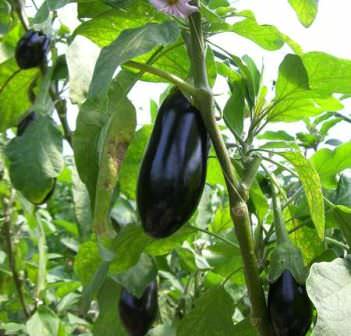

If the lump on the roots is fragile, then to strengthen it, you can prepare a chatterbox from clay and mullein. And, as necessary, lower the roots there.
In order not to have such problems, it is better to grow seedlings in pots. Such seedlings will take root faster, the fruits will ripen earlier, and will give a greater yield.
After planting, you need to create shade for the seedlings until they get used to the sunlight. And it would be nice to spray the soil. This will increase the humidity in the greenhouse, which eggplants love so much.
Agrotechnics
Eggplants are grown from seedlings. Seeds for seedlings must be sown in the last days of March. The seeds are pre-soaked in a stimulating solution.
If you do not want to waste time waiting for the emergence of seedlings from the ground, you can, after soaking in a stimulating solution, "sow" the seeds of the hybrid into a damp cloth. At the same time, it will be possible to assess the quality of the seeds. Sprouted seeds are planted in separate seedling cups in the prepared soil.
You can simply sow the seeds in the seedling box and open them later. But eggplants do not tolerate both picking and transplanting, often freezing in growth for a long time. Therefore, the best option is to transfer the young plant from the seed cup to the ground to a permanent place.
When growing eggplant seedlings, novice gardeners often complain that the seeds sprung up together and suddenly everything fell. Most likely, the seedlings were affected by rot of the root collar. This fungal disease develops in overly moist soil. Eggplants are the record holders for water consumption among nightshades, but even they do not like the "swamp".
With an excess of water in plants, roots begin to rot. Further rot spreads to the stem. If this happens, most likely, the seedlings will have to be re-grown.
When the seedlings reach two months of age and the end of the frost, the seedlings can be transplanted into the ground. When planting in open ground, you should take care of protecting the plants from the cold wind by placing acrylic on the north side.
It is better to "warm" eggplant roots by planting them in organic-rich soil and covering them with mulch. At the same time, it will get rid of weeds.
In dry hot weather, it is necessary to monitor the absence of a spider mite that can deprive the gardener of the harvest. The pest is destroyed with an insecticide.
The situation is worse with the Colorado potato beetle. It multiplies quickly, flies far. It is susceptible to the action of an insecticide, but the chemicals should not be applied later than twenty days before harvest. During this time, the Colorado potato beetle is able to cause significant damage to eggplants, which he loves more than other nightshades.
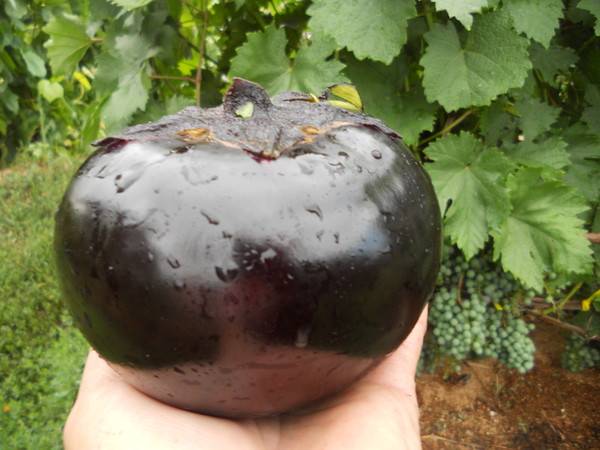

Hybrid Bourgeois F1 is a product of CeDeK.Perhaps, when growing eggplants and protecting them from pests, it is worth listening to their advice.
Tips from SeDeK
Natural remedies can be used to protect against pests. The Colorado potato beetle is deterred by horseradish, calendula, coriander, beans. Parsley, fennel, garlic and rosemary repel gastropods. In addition, eggplants get along well with beans.
For good fruiting, eggplant flowers must be illuminated by the sun. Do not be afraid to pinch off the leaf shading the flowers.
You should not leave more than two to three stepsons and five to eight fruits at the same time on the bushes. The number of fruits depends on their size. The larger the fruits, the less they should be on the bush.
Eggplant should be watered twice a week. It is also necessary to monitor the potassium-phosphorus balance in the soil.
Sometimes you can find negative reviews about the Bourgeois hybrid on the forums. But if you start to understand, it turns out that the seeds of the Bourgeois F1 hybrid were purchased from hands. In other words, these are second-generation plants that can produce good fruits, can produce disgusting vegetables, and may not disfigure anything at all. Depends on the varieties that were used to breed the hybrid. Producers are trying to ensure that the fruits of the first generation hybrids meet the requirements for the qualities of this variety of eggplants.
In the second generation, there is a splitting of the traits of the offspring. At the same time, no one knows exactly how the alleles will be distributed. Not two or three gene alleles are responsible for the quality of eggplants, but much more. Many signs are also linked. Nobody canceled Mendel's second law either.
In general, you do not need to buy hybrid seeds from your hands, no matter how the seller praises you with his own experience of growing this hybrid. Perhaps he even speaks the pure truth, he just bought the first generation seeds from the grower.
About the eggplant of the Bourgeois variety, reviews of summer residents who bought branded hybrid seeds, if they contain negative, then only to the address of pests.

